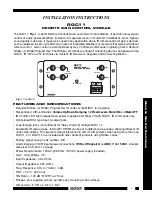
To the following times an access takes place on a storage medium:
After overall reset
n
The CPU checks if a VSC is inserted. If so, the corresponding optional functions are
enabled.
n
The CPU checks whether a project S7PROG.WLD exists. If so, it is automatically
loaded.
After PowerON
n
The CPU checks whether a project AUTOLOAD.WLD exists. If so, an overall reset is
executed and the project is automatically loaded.
n
The CPU checks whether a command file with the name VIPA_CMD.MMC exists. If
so the command file is loaded and the commands are executed.
n
After PowerON and CPU STOP the CPU checks if there is a *.pkg file (firmware file).
If so, this is shown by the CPU by blinking LEDs and the firmware may be installed by
an update request.
Chapter 4.13 ‘Firmware update’ on page 86
Once in STOP state
n
If a memory card is plugged, which contains a command file VIPA_CMD.MMC, the
command file is loaded and the containing instructions are executed.
The FC/SFC 208 ... FC/SFC 215 and FC/SFC 195 allow you to include
the memory card access into your user application. More can be found in
the manual "Operation list".
4.16 Extended know-how protection
Besides the "standard" Know-how protection the CPUs from VIPA provide an "extended"
know-how protection that serves a secure block protection for accesses of 3. persons.
n
Standard protection
–
The standard protection from Siemens transfers also protected blocks to the PG
but their content is not displayed.
–
But with according manipulation the know-how protection is not guaranteed.
n
Extended protection
–
The "extended" know-how protection developed by VIPA offers the opportunity to
store blocks permanently in the CPU.
–
With the "extended" protection you transfer the protected blocks to a memory card
into a WLD-file named protect.wld.
–
By plugging the memory card and then an overall reset the blocks in the pro-
tect.wld are permanently stored in the CPU.
–
You may protect OBs, FBs and FCs.
–
When back-reading the protected blocks into the PG, exclusively the block header
are loaded. The block code that is to be protected remains in the CPU and cannot
be read.
1.
Create a new wld file in your project engineering tool with
‘File
è
Memory Card file
è
New’
.
2.
Rename the wld file to "protect.wld".
3.
Transfer the according blocks into the file by dragging them with the mouse from
the project to the file window of protect.wld.
4.
Transfer the file protect.wld to a memory card.
Accessing the storage
medium
Overview
Protect blocks with pro-
tect.wld
VIPA System SLIO
Deployment CPU 013-CCF0R00
Extended know-how protection
HB300 | CPU | 013-CCF0R00 | en | 17-20
90
















































